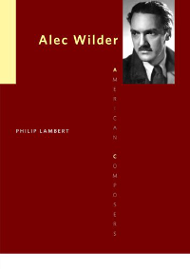
Urbana: University of Illinois Press, 2013 153 pp
ISBN: 978-0-252-03760-3vb
Philip Lambert’s thoroughly researched biographical analysis of Alec Wilder (1908-1980) fills a significant gap in the literature about a composer whose music and life present particular challenges.
Wilder is an unclassifiable musical rarity, one of the few composers to have established a major reputation as both a composer of solo, chamber and orchestral works, and as a composer of popular songs. He was a prolific composer of large orchestral works, operas and shorter stage works, hundreds of art songs as well as dozens of solo instrument works that focused on what Wilder’s associate and publisher Gunther Schuller called the “underdog instruments” such as bassoon and oboe, tuba and trombone, saxophone, and horn. Uniquely, Wilder is equally known as a composer of landmark popular songs. His lush, chromatic harmonies have attracted many vocalists and jazz musicians, despite (or perhaps because of) the challenges of his melodies and extended song forms. However, Wilder’s musical vocabulary cannot be simply categorized as “classical” and “jazzy.” His popular songs have many elements of art song, with sweeping melodies and extended forms that transcend the basic Tin Pan Alley AABA genre; similarly, his chamber music and solo works often dart between stylistic worlds from phrase to phrase, sometimes recalling Hindemith or Bartók in one moment, then immediately requiring the performer to meld into a swing style in the next phrase.
Wilder was man of many contradictions. He was a Rochester, New York native who loved the unique musical environs of the Eastman School of Music, but detested the world of formal education, often short-circuiting potentially fruitful relationships with mentors, or getting into infamous scrapes with Eastman Director Howard Hanson. He was a huge personality and would loudly declare his musical opinions at room-filling volume, but was inwardly shy when a more formal spotlight was on him. He was fiercely loyal to his friends and those he admired—who inspired him to create many of his solo and chamber works—but he did not suffer fools easily. He was an admirer of beautiful melody and lush harmony in an era when atonality reigned. (Whitney Balliett titled his 1972 New Yorker Wilder profile “President of the Derriere-Garde.”) Wilder was famously caustic in his criticism of modernists whom he called “neophiliacs,” and his abhorrence of the music industry and its publicity machinery cost him well-deserved wider recognition on numerous instances. He was a true nomad who lived at New York’s Algonquin Hotel for over 50 years, leaving all of his belongings in two suitcases behind the hotel’s switchboard. (“I want to be able to leave wherever I am in less than ten minutes,” he would say.) When he had a piece to write, he would board a train—to anywhere—and keep changing trains randomly until the piece was completed, sometimes staying in that final destination for days or weeks afterward. He frequented the homes of his valued friends, including photographer and lifelong friend Louis Ouzer and his wife Helen in his hometown Rochester, Harvey Phillips in Indiana, or Mitch Miller on Long Island.
Wilder was also a gifted writer and author of several important books, most notably the landmark American Popular Song: The Great Innovators, 1900-1950 (Oxford, 1972), which contains Wilder’s acerbic, often admiring yet unflinching analyses and excerpts of over 1200 songs, a book which is still considered one of the great resources on this subject. It is ironic that Wilder, in true self-sabotaging character, made not one mention of his own songs in the text.
Author, music theorist, and Baruch College faculty member Philip Lambert has, in many ways, supplied Wilder’s important missing chapter in his own book, Alec Wilder, part of the University of Illinois Press American Composers Series. In accomplishing this, Lambert went to all of the right original sources, including archival holdings at the Wilder Archive at the Eastman School of Music, the Wilder Papers at New York Public Library, Judy Bell at the Richmond Organization (publisher of Wilder’s popular songs), and Wilder’s published works. The book draws upon dozens of quotes from Wilder’s unpublished autobiographical manuscripts Life Story, The Search and The Tuxedo, as well as published sources such as Desmond Stone’s biography Alec Wilder In Spite of Himself (Oxford, 1996), Alec Wilder: A Bio-Bibliography (Greenwood Press, 1993) by Ronald Prather and this author, and Wilder’s own peculiarly wonderful Letters I Never Mailed (Little Brown, 1975, 2nd ed. 2005).
The result is the first-ever commercially published analytical overview of Wilder’s widely varied compositional output, put into the context of his unique life. Lambert’s broad musical background uniquely qualifies him to deal with all of this, with the analytical acumen to dissect the full Wilder compositional continuum, the chromatic harmonies of Wilder’s songs and art songs to his jazz-oriented suites, solo sonatas and more formal concerti.
The book is laid out chronologically, with a tone that might be best described as a musical biography. The story of Wilder’s life is told in good detail, with numerous musical references and to highlight examples that often speak as directly to Wilder’s personality as Lambert’s the powerfully written tale of his life. In addition to his fine writing, Lambert also adds detailed endnotes, and wisely chosen lists of selected Wilder works, recordings and readings.
The first two chapters, “Awakenings: Musical Experiences through the Early 1930s” and “Breakthroughs: First Professional Successes” deal with Wilder’s childhood and professional beginnings. Lambert delves into Wilder’s published and unpublished autobiographical writings to relate Wilder’s own accounts of his early compositional attempts. Some of those attempts made it into shows that met with varying levels of success; all featuring moments of notable harmonic or melodic interest, nested within the 32-bar AABA forms that music theater convention demanded at the time. Two of Lambert’s earliest examples are Wilder’s art song “I Felt a Funeral” with text by Emily Dickinson, carried by Wilder’s intervallic clusters under a snaking melody, and the bridge of “Once in a Million Years” where the melodic structure makes an unorthodox ascent through the notes of a diminished triad. Wilder was at this time bouncing back and forth between the hallowed Eastman halls as a private composition student, and his first encounters in the New York City music theater scene. His dual approach to popular song and chamber music came at the prodding of his childhood confidante Carroll Dunn, and his first successes came in theater songs and big band arranging. The first broader recognition of Wilder’s unique gifts came through his now-famous Octets (for five winds, harpsichord, bass and drums), some of which were minor hit records; several are analyzed by Lambert, including some of Wilder’s best, most whimsical titles, like “Neurotic Goldfish,” “Debutante’s Diary,” and the evocative “Jack, This is My Husband.” Lambert adds immediacy by including a photo of the first score page of “Little Girl Grows Up.” It was after this period that Wilder wrote some of his most successful songs, including “I’ll Be Around” and “While We’re Young,” subsequently recorded by some of the great American singers, and discussed here by Lambert. During the recording strike of 1943, Wilder won the support of Frank Sinatra when he created vocal-only backing arrangements for the megastar, helping Sinatra sustain his visibility by working around the labor conflict. Wilder’s career was off and running.
The third and fourth chapters, “Evolutions: Compositional Maturity” and “Loyalties: The Prolific Sixties” embrace the bulk of Wilder’s New York career in the 1950s-60s that included Wilder’s new status as “composer” rather than simply as songwriter and arranger. Aside from landmark songs such as “The Winter of My Discontent” and “Listen to Your Heart,” Wilder also wrote an album’s worth of arrangements for wind septet and rhythm section for guitarist Mundell Lowe, highlighted by Lambert’s analysis of “What Happened Last Night.” Lambert also pulls from material in one of Wilder’s horn sonatas for John Barrows; his Oboe Concerto for oboist, Eastman friend, soon-to-be Columbia Records power broker Mitch Miller; and from Woodwind Quintet No. 2 and “Sketches for the World’s Most Beautiful Girls,” both for the New York Woodwind Quintet. The latter is a set of girl-themed popular song arrangements that showcases the entire spectrum of Wilder’s stylistic vocabulary, from near-atonal settings to cabaret lyricism and big band swing—all expertly chronicled by Lambert. The fourth chapter takes a clear snapshot of Wilder in cultural perspective via his New York Times article on rock music. While realizing that pop music culture had clearly passed by his own songwriting style, he rails against the success of untrained amateurs. Lambert quotes Wilder: “While amateurs can produce miracles, they can only do it once.” Lambert highlights “crossover” concertos Wilder wrote for the great tenor saxophonists Stan Getz and Zoot Sims, and for trumpet legends Clark Terry and Doc Severinsen, all with orchestral accompaniment. A highlight of this chapter, and of Wilder’s career, is the anti-war cantata Children’s Plea for Peace, premiered in his native Rochester with text taken from the messages written by area schoolchildren about war, sung by children’s choir with orchestra.
The fifth chapter, “Celebrations: Reflection and Reaffirmation in the 1970s,” portrays Wilder in his prime, right where he wants to be—becoming a major author and writing music for his trusted friends, many of whom had risen to powerful positions in the industry and in higher education. During this period, Wilder began working with lyricist/composer Loonis McGlohon, and deepened his long connection with Marian McPartland, who recorded an entire album of Wilder’s music, as did fellow pianist Roland Hanna. A major portion of this fifth section consists of Lambert’s review-within-a-book of Wilder’s landmark text American Popular Song, devoting a full seven-plus pages to a detailed study of Wilder’s comments and more particularly his methodology and thought process. Lambert apparently drew well from this study; his work in this book is at the same high musical level as Wilder’s.
In Lambert’s final chapter, “Assessment,” he makes two good points: first, that Wilder was ahead of his time for his combination of jazz and classical influences, creating “third-stream music” in the forties long before that term existed; and second, Wilder was also decades ahead of our culture by drawing from widely diverse elements to create sounds and combinations that twenty-first century listeners are still in many ways trying to digest and internalize, 35 years after his death. Lambert’s final critical observation is perhaps his most important: that despite the uniqueness of Wilder’s breadth of musical styles and influences, the quality of his melodic and harmonic gifts shine when considered on their own.
This book is a seminal work for anyone interested in one of our great, but under-recognized musical voices. Its much-needed publication is already being celebrated by those already aware of Wilder’s genius. Lambert’s expertise in the vocal area puts particular focus on that part of the Wilder repertoire. While the instrumental realm is well covered, some particular fans of Wilder’s instrumental sonatas, suites and concerti may have wished for more attention to the workings of those pieces. The upside, however, is in Lambert’s more detailed concentration on Wilder’s vocal output, where he highlights some vocal music here for the first time, new even to those familiar with Wilder’s repertoire. This book belongs in any library, beside Wilder’s own masterpiece, American Popular Song.



